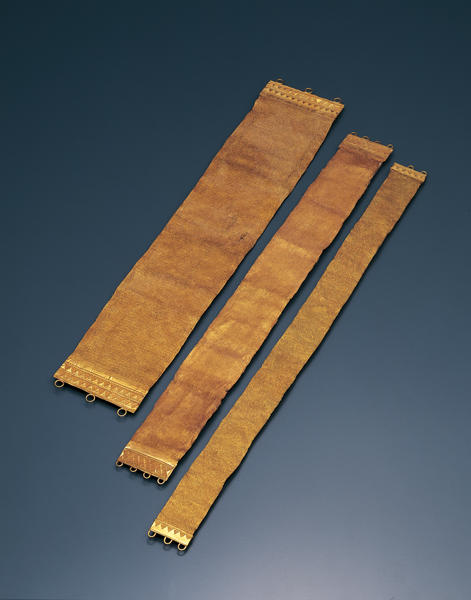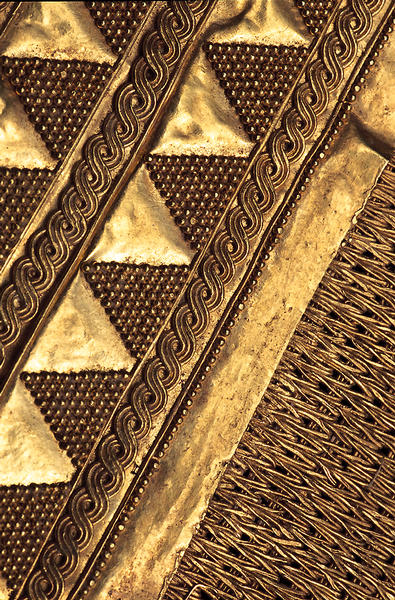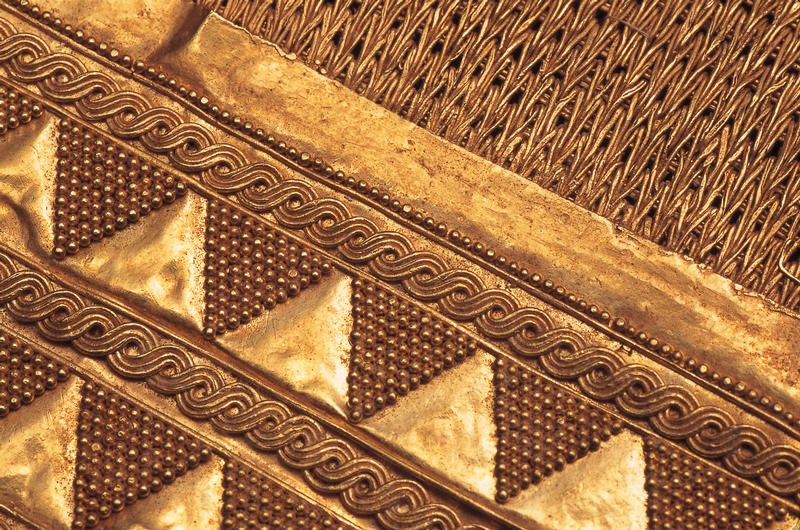Three Straps
- Mesopotamia or western Iran
- 8th - 6th century B.C.
- Gold
- H-51.5 W-5.8
Catalogue Entry
The first fine-mesh strap, A, has wide flat terminals decorated with a fine network formed by a row of diamond-shaped patches of granulation framed by inward-pointing triangular patches of granulation. The edges of this arrangement are bordered by two guilloches of gold wire with an additional row of granulation along each outside edge. Four nearly circular attachment rings with somewhat flattened bases are fused to the edge of each terminal. The gold strap is made of interlocking loops of hand-made, twisted and heated wire woven in a double loop-in-loop chain on a "weft" of long narrow gold loops. Damage to the strap visible in lines of bent and compressed links show that the strap was folded into a small packet and apparently was under pressure for some time. The lines suggest that the band was folded back and forth in a roughly accordion-like manner. It was not folded in half symmetrically and then in quarters.
The second example, B, the widest of the straps, has terminal plates with two rows of outward-pointing triangular patches of granulation. These triangles are framed by three guilloches of three wires each bordered by straight lines formed by a single thin gold wire. The outermost edge of the plate where the fastening rings are attached has a now-fragmentary line of fine granulation. A similar, better preserved line of granulations also marks the edge of the decoration on the strap side. The effect of the arrangement is visually bolder and stronger than the interlocking pattern of the first belt. Compression patterns suggest that this band was folded in thirds for a prolonged period. This very wide band is further damaged with noticeable longitudinal tears along the upper and lower edges of the strap.
The third strap, C, narrow and slightly longer than the other two, is the least damaged of the three. The metal of the terminal plates is thick and has a single row of triangular patches of granulation on the edge adjacent to the strap. The granulation was irregularly set; the loss of some granules erodes the precision of the ornament. The triangles point toward the outer edge of each plate from a baseline defined by two rows of strip-twisted wire between smooth wire borders. Three loops (one of which is now missing) secured each end of the band to its backing. These loops, thicker than the loops on the other two bands, have an almost semicircular shape which further distinguishes this piece.
The production of gold straps, that is, parallel chains that are also linked to each other in a variety of ways to form a broad and flexible textile-like material, is best known in the Aegean where from the fourth century B.C. onwards gold strap necklaces were produced. Recent discoveries in northern Mesopotamia, however, show that gold straps were produced there as early as the eighth century B.C.1 While the manner in which the Shumei bands were formed has Aegean parallels, the terminals of the bands, or belts, point to a Near Eastern rather than Aegean origin. Double guilloche borders rendered in applied wire and rows of triangular and diamond-shaped patches of granulation have a long history in West Asian metalwork. They do not appear on classical jewelry, which display curvilinear floral and vegetal forms even when produced for West Asian patrons.2 Geometric decoration based on granulation rather than filigree is a common feature of the ornamental gold caps on some ancient Near Eastern cylinder seals and jewelry as early as the mid-second millennium B.C.3 Likewise, the use of a double guilloche to border the granulated zones also has Mesopotamian parallels of the mid-second millennium B.C. and Iranian examples of the twelfth century B.C.4 Excavated jewelry from the Neo-Assyrian period (ninth-seventh centuries B.C.) in Mesopotamia features both diamond-shaped patches of granulation and borders of smooth and strip-twisted wire.5 Thus both the double loop-in-loop technique itself and the decorative patterns of the terminals are not dependent on the Aegean goldsmithing tradition. The simple fusing of the strap to the terminal plates also shows no influence from the Greek tradition, which features mechanical joining by means of pins and/or hinges often protectively covered by a box-like enclosure usually with a tapered profile.6 Similarly, the circular and nearly circular loops fused to the terminal plates do not have Greek parallels.
The treatment of gold wire as if it were thread occurs in Anatolia as early as 1800 B.C.,7 and examples of fiber thread wrapped with precious metal and then woven to form a golden cloth are known from later periods in the Near East.8 Nonetheless, no close excavated parallels to the Shumei bands are known. Two smaller and more damaged straps are without archaeological context.9
Likewise the manner in which these bands were used is uncertain. Clearly they were too fragile to be worn by themselves, secured only by laces through the loops, but needed the support of a stronger backing like textile or leather. Since there is no archaeological context for these works, we cannot be sure that they were worn as belts, that is at or around the waist. Indeed it is possible that they were not meant to be worn by humans at all, but were part of some divine regalia. Golden ornaments and clothing for divine images are well-documented in Mesopotamia in the first millennium B.C.10 No comparable written evidence exists for western Iran, but one may assume a general parallelism.
TSK
1. Williams and Ogden 1994, p. 26. See also Harrington and Lyons 1990, pp. 48-53.
2. Williams and Ogden 1994, nos. 53, 64, 84, 121, pp. 99, 112-13, 142, 188-89.
3. Lilyquist 1994, p. 15, fig. 21j-l, p. 16, fig. 22, pp. 19, 25-27. See Collon 1987, pp. 50-51, nos. 198-99; and Lilyquist 1993, p. 77, fig. 6c, for impressions of cylinder seals having caps decorated with granulated triangles.
4. Maxwell-Hyslop 1971, pp. 164, 187, pls. 127, 134.
5. Ibid., pp. 233-35, pls. 216, 218.
6. Williams and Og


